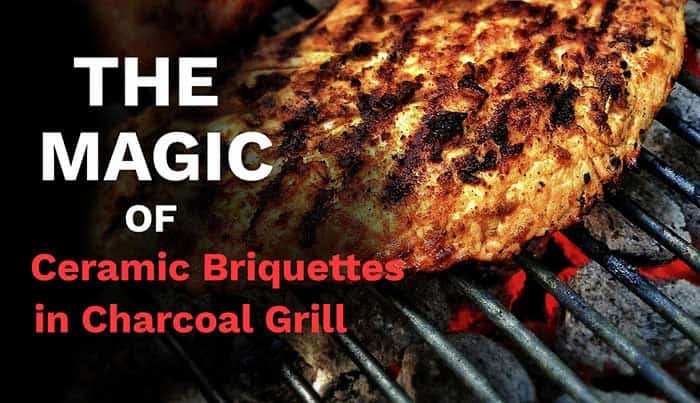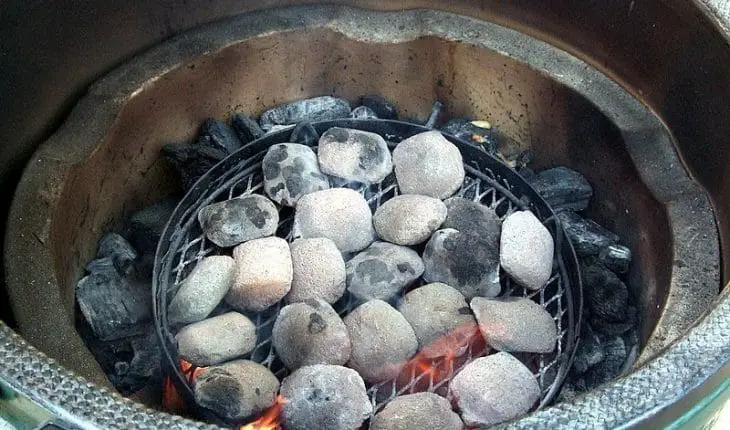Ceramic briquettes are a lesser-known accessory option for charcoal and gas grills. They’re responsible for reducing fuel consumption and can help enhance the flavor of the food cooked on the grill by improving its performance.
They’re available in a variety of different styles and they play a huge role in regulating even heat distribution.
But the ceramic briquette’s main job is to assist in ensuring that the right amount of heat is produced and to prevent overheating or overuse of fuel.

In this post we'll cover:
Who Should Use Ceramic Briquettes?
It’s difficult to say what category of user needs to use ceramic briquettes. What we can say though is that they help distribute heat more efficiently and evenly than lava rocks.
Thus, ceramic briquettes can help you avoid overcooking or burning meats but without sacrificing a perfect sear.
Many prefer to use ceramic briquettes when cooking with direct heat and many users have reported that using them leads to much better tasting meat.

The Benefits of Ceramic Briquettes
Ceramic briquettes are designed in such a way that they offer a variety of benefits to different users. The main benefit, of course, is the fact that they help save energy and money.
Who doesn’t want to save a few extra bucks on grilling fuel, right?
Some users have mentioned that this particular accessory can also improve the taste and aroma of the meat that you cook with your grill.
That’s because they allow for even heat distribution through quick absorption of as much heat as possible after you light it up.
That way, you can just cook your food using the heat from the briquettes and turn off the gas altogether and enjoy slow-cooked meat and vegetables with an authentic and nostalgic smoky flavor.
The best part about ceramic briquettes is that they’re super easy to use.
Ceramic Briquette Styles
Ceramic briquettes come in a wide variety of different styles, including rounded shape briquettes, pyramid-shaped briquettes and other options that allow for the grease to flow through, enabling ease of cleaning later on. In fact, using briquettes (even charcoal ones) could be the easiest way to ensure ease of maintenance for your grill because all you have to do is turn them over and let the excess drippings burn off the next time you fire up the grill.
It’s a simple yet effective solution that has endeared ceramic briquettes to many grill masters. So it doesn’t matter what shape you choose, ceramic briquettes are all basically the same and they’re made from the same stuff.
Specialty Flavored Ceramic Briquettes
Like we mentioned, ceramic briquettes are known for imparting an authentic smoked flavor to meat.
That’s because ceramic briquettes are actually manufactured using real hardwood and their smoky flavor activates when you heat them up to a certain level.
Of course, the depth of flavor will depend on the type of hardwood that the ceramic briquette was made from and it’s recommended to consider that when buying them so you can choose an option that’s well suited to the type of meat that you’re making.
The following is a selection of the available flavors in ceramic briquettes:
- Hickory – Offers a slow burn that produces a unique aroma and classic smoked flavor. It’s a favorite for smoking pizza, vegetables and all types of different meats.
- Mesquite – This type of wood is widely used in the Southwestern region of the US, especially in Texas where it’s widely available. It offers a quick burn that comes with a very unique flavor as well.
- Cherry – Pitmasters often recommend cherry wood for preparing pork and beef because it burns slow and offers a distinctive taste. Plus, meat that’s cooked in cherry wood tends to develop a unique mahogany color that makes for a great presentation.
- Peach – Peach is a very special kind of hardwood that’s mostly used by expert grillers. You have to be careful with this one and you only want to use it for sweetmeats because it does come from a sweet fruit tree after all.
- Apple – You can use apple tree wood to cook pretty much anything. It brings out the best flavors in bacon and pork especially.
- Pecan – This is another crowd pleaser that works with most types of meat. However, it requires a fair amount of hands-on management as it can turn the meat bitter when left on for too long.
If you already have a right choice for briquettes, don’t forget to buy a charcoal grill to make a special grill dish.
What’s Better Lava Rock or Ceramic Briquettes?
One of the major concerns that come to the mind when grilling meat is heat distribution. Without this essential function, a gas grill can be difficult to work with.
It’s important that the food you cook is evenly cooked through without you having to constantly check on the flame or anything like that.
This is where ceramic briquettes come in. They’re very effective at ensuring efficient heat distribution and this is why they’re a favorite option among many manufacturers.
In fact, that’s why ceramic briquettes were introduced decades ago to replace lava rocks.
They offer a cleaner burn with better heat retention qualities.
While lava rocks make for a messy cooking experience that needs plenty of clean-up afterward, ceramic briquettes last longer and are easier to clean because they allow the drippings to filter through easily.
Ceramic briquettes are a great way to ensure even heat distribution across the entire cooking surface and they offer excellent heat retention while using less fuel.
You see, ceramic briquettes are great when it comes to absorbing heat early on in the cooking process. This means you can turn the gas off and they’ll continue to cook your meat beautifully, albeit slowly.
Plus, the grease drippings remain on the ceramic briquettes so that next time you use them they release a delectable aroma that adds exceptional flavor to your food.
Not only will you grill better tasting meat and vegetables when using ceramic briquettes, but you’ll find that clean-up is easier afterward too. All you need is a brush to sweep away the remaining debris and you’re good to go.
Another important point to note is that ceramic briquettes last much longer than lava rock and they’re the closest thing you can get to actual charcoal but without the use of lighter fluid and chemicals that come with the latter.
Furthermore, ceramic briquettes are available in a variety of shapes and sizes. You have rectangular, round and square shapes or you can opt for the unique pyramid shaped and flat ones.
Regardless of the size or shape you choose, the result will be the same – better heat distribution and retention.
When working with ceramic briquettes, you’ll find that they’re considerably easier to install as long as you place them evenly onto the briquette tray, rock grate or whichever relevant surface your grill uses.
They’ve become so popular that ceramic briquettes are now available in a variety of different flavors to ensure that you never go without flavor no matter what type of meat you’re cooking.
We also love the durability of ceramic briquettes because they take years to disintegrate, which means you can go for endless seasons without having to replace them. Eventually, they’ll either crack or break on their own.
You can use ceramic briquettes instead of lava rocks in your grill and you’ll never have to worry about clogged burner holes again.
As a result, your grill will be easier to clean and maintain in the long run and you’ll enjoy consistent heat distribution and retention as well.
All in all, ceramic briquettes are a fantastic option and we’d recommend them over lava rocks any day.
Can You Clean Ceramic Briquettes?
Ceramic briquettes are a long-lasting, energy saving and reliable source of fuel for the modern-day grill master. They’ll help you prepare the best rotisserie chicken, turkey or steak that you’ve ever smoked on your grill.
But, eventually, you’ll have to clean your briquettes when they start to crumble and break otherwise they could affect the performance of your grill.
Here’s a step-by-step process to show you how.
Step 1
Turn the briquettes over one by one while making sure that the greasy side is facing down. Ignite your grill and close its lid. Crank the heat up to the highest temperature and leave them to burn for 15 minutes.
Step 2
Switch off the grill and leave the briquettes to cool off. Pour strong detergent soap and hot water into a closed sink and place a towel at the bottom of the sink.
Put the briquettes into the water solution and leave them to soak for a couple of minutes or so. The towel will help prevent the briquettes from coming into contact with the bottom of the sink.
Step 3
Get a nylon scrub pad and use it to scrub the briquettes clean.
Step 4
Rinse the briquettes under clean running water and let them air dry before you place them into the grill again.
Can You Use Ceramic Briquettes in a Charcoal Grill?
Ceramic briquettes charcoal grill use is a popular discussion in many pitmaster forums and for a good reason. The two make for a good combination. The simple answer to this question is yes, you may use ceramic briquettes in a charcoal grill.
Those who have tried ceramic briquettes charcoal grill combination can attest to experiencing better heat retention and temperature control.
They’re perfect for slow cooking; searing, direct heat cooking and they’ll last longer than your average lava rocks.
